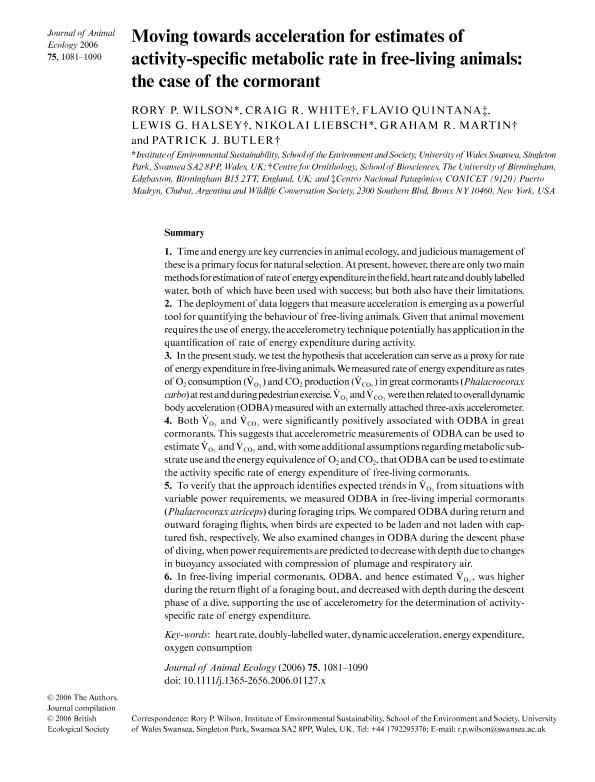Artículo
Moving towards acceleration for estimates of activity-specific metabolic rate in free-living animals: the case of the cormorant
Wilson, Rory P.; White, Craig R.; Quintana, Flavio Roberto ; Halsey, Lewis G.; Liebsch, Nikolai; Martin, Graham R.; Butler, Patrick
; Halsey, Lewis G.; Liebsch, Nikolai; Martin, Graham R.; Butler, Patrick
 ; Halsey, Lewis G.; Liebsch, Nikolai; Martin, Graham R.; Butler, Patrick
; Halsey, Lewis G.; Liebsch, Nikolai; Martin, Graham R.; Butler, Patrick
Fecha de publicación:
09/2006
Editorial:
Wiley Blackwell Publishing, Inc
Revista:
Journal Of Animal Ecology
ISSN:
0021-8790
Idioma:
Inglés
Tipo de recurso:
Artículo publicado
Clasificación temática:
Resumen
1. Time and energy are key currencies in animal ecology, and judicious management of these is a primary focus for natural selection. At present, however, there are only two main methods for estimation of rate of energy expenditure in the field, heart rate and doubly labelled water, both of which have been used with success; but both also have their limitations. 2. The deployment of data loggers that measure acceleration is emerging as a powerful tool for quantifying the behaviour of free-living animals. Given that animal movement requires the use of energy, the accelerometry technique potentially has application in the quantification of rate of energy expenditure during activity. 3. In the present study, we test the hypothesis that acceleration can serve as a proxy for rate of energy expenditure in free-living animals. We measured rate of energy expenditure as rates of O2 consumption (√O2 ) and CO2 production (√CO2 ) in great cormorants (Phalacrocorax carbo) at rest and during pedestrian exercise. √O2 and √CO2 were then related to overall dynamic body acceleration (ODBA) measured with an externally attached three-axis accelerometer. 4. Both √O2 and √CO2 were significantly positively associated with ODBA in great cormorants. This suggests that accelerometric measurements of ODBA can be used to estimate √O2 and √CO2 and, with some additional assumptions regarding metabolic substrate use and the energy equivalence of O2 and CO2, that ODBA can be used to estimate the activity specific rate of energy expenditure of free-living cormorants. 5. To verify that the approach identifies expected trends in √O2 from situations with variable power requirements, we measured ODBA in free-living imperial cormorants (Phalacrocorax atriceps) during foraging trips. We compared ODBA during return and outward foraging flights, when birds are expected to be laden and not laden with captured fish, respectively. We also examined changes in ODBA during the descent phase of diving, when power requirements are predicted to decrease with depth due to changes in buoyancy associated with compression of plumage and respiratory air. 6. In free-living imperial cormorants, ODBA, and hence estimated √O2, was higher during the return flight of a foraging bout, and decreased with depth during the descent phase of a dive, supporting the use of accelerometry for the determination of activity-specific rate of energy expenditure.
Archivos asociados
Licencia
Identificadores
Colecciones
Articulos(CCT-CENPAT)
Articulos de CTRO.CIENTIFICO TECNOL.CONICET - CENPAT
Articulos de CTRO.CIENTIFICO TECNOL.CONICET - CENPAT
Citación
Wilson, Rory P.; White, Craig R.; Quintana, Flavio Roberto; Halsey, Lewis G.; Liebsch, Nikolai; et al.; Moving towards acceleration for estimates of activity-specific metabolic rate in free-living animals: the case of the cormorant; Wiley Blackwell Publishing, Inc; Journal Of Animal Ecology; 75; 5; 9-2006; 1081-1090
Compartir
Altmétricas



